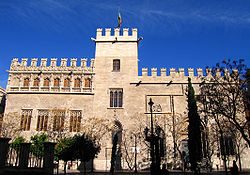La Llotja
| Silk Exchange | |
|---|---|
|
Native names Catalan: Llotja de la Seda Spanish: Lonja de Seda |
|
 |
|
| Location | Valencia, Valencian Community, Spain |
| Coordinates | 39°28′27.9″N 0°22′42.4″W / 39.474417°N 0.378444°WCoordinates: 39°28′27.9″N 0°22′42.4″W / 39.474417°N 0.378444°W |
| Architect | Pere Compte |
| Architectural style(s) |
Gothic Renaissance |
| Official name: Lonja de la Seda de Valencia | |
| Type | Cultural |
| Criteria | i, iv |
| Designated | 1996 (20th session) |
| Reference no. | 782 |
| State Party |
|
| Region | Europe and North America |
| Official name: Lonja de la Seda | |
| Type | Real property |
| Criteria | Monument |
| Designated | 3 June 1931 |
| Reference no. | (R.I.) - 51 - 0000968 - 00000 |
The Llotja de la Seda (Valencian pronunciation: [ˈʎɔdʒa ðe la ˈseða], Spanish: Lonja de la Seda, English "Silk Exchange") is a late Valencian Gothic-style civil building in Valencia, Spain. It is a principal tourist attraction in the city.
Built between 1482 and 1548, la Lonja is composed of three parts (plus the Orange Garden - a walled court-yard). The main hall, Sala de Contratacion (The Contract Hall) is a large lavishly decorated space supported by gorgeous twisted columns. This was the financial centre of La Lonja, where the merchants work out contracts. The side-wing is named the Pavilion of the Consulate, and this was the seat of the Tribunal del Mar - the first marine merchant tribunal to ever be formed in Spain. The first two floors were the main function rooms, with the upper one hosting a richly decorated ceiling. These rooms are still maintain original furnishings. On occasion, the Tribunal would imprison merchants for debts in the central tower of La Lonja - the third part of the structure.
Behind the current building, there was an earlier one from the 14th century, which was called the Oil Exchange (Llotja de l’Oli, in Valencian, or Lonja del Aceite, in Spanish). It was used not only for trading with agricultural oils, but for all kind of business. Where in 1348 was traded perxal (percale) as some kind of silk.
Valencia's commercial prosperity reached its peak during the 15th century, and led to the construction of a new building.
The design of the new Lonja of Valencia was derived from a similar structure in the Lonja of Palma de Majorca, built by the architect Guillem Sagrera in 1448. The architect in charge of the new Lonja was Pere Compte, who built the main body of the building – the Trading Hall (or Sala de Contractació in Valencian) – in only fifteen years (1483–1498). So is written in a blue band that runs along all four walls of the Trading Hall, also called "Hall of Columns". It proclaims in golden letters the following inscription:
Inclita domus sum annis aedificata quindecim. Gustate et videte concives quoniam bona est negotiatio, quae non agit dolum in lingua, quae jurat proximo et non deficit, quae pecuniam non dedit ad usuram eius. Mercator sic agens divitiis redundabit, et tandem vita fructur aeterna.
...
Wikipedia
